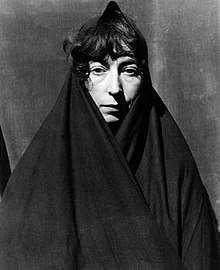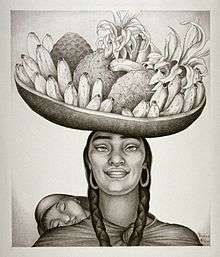Maxine Albro
Maxine Albro (January 20, 1893 Ayrshire, Iowa – July 19, 1966 Los Angeles) was an American painter, muralist, lithographer, mosaic artist, and sculptor. She was one of America's leading female artists, and one of the few women commissioned under the New Deal's Federal Art Project, which also employed Jackson Pollock, Mark Rothko, and Willem de Kooning.
Maxine Albro | |
|---|---|
 Maxine Albro, photographed by Imogen Cunningham in 1931 | |
| Born | 20 January 1893 |
| Died | 19 July 1966 (aged 73) |
| Nationality | American |
| Known for | Painting, Mural, Lithography, Mosaic, Sculpture |
Life

Ethel Maxine Albro was born in 1893 in Ayrshire, Iowa, the daughter of Frank Albro,[1] a grain buyer[2] and piano salesman,[3] and Cordelia Mead.[4] She had an older brother, Francis, and a younger brother, Harold.[2] She spent part of her youth in Estherville, Iowa.[2] She grew up in Los Angeles.[5] Her father's family came from England and settled in Rhode Island before moving west,[6] and her mother's ancestors were of Irish-English descent.[7]
In 1920, she moved to San Francisco where she studied at the California School of Fine Arts from 1923 to 1925. A year later, she enrolled in the Art Students League of New York. In the early 1920s, she lived in Burlingame, California.[8] In 1927, she studied at Académie de la Grande Chaumière in Paris, before embarking to Mexico, where she would study underneath one of Diego Rivera's assistants, and eventually make the acquaintance of Diego Rivera.[9]
Albro was one of the few women who were part of the Works Progress Administration's Federal Art Project, a program initiated under President Franklin Roosevelt's New Deal. Due to the high rate of joblessness during the Great Depression, these art programs were required to employ female artists, making this period the first time in history in which women were hired without discrimination in the United States.
Throughout the 1930s, Albro executed many commissions under the federal program, including murals at Coit Tower and a mosaic at San Francisco State University.
None of the artists working on the mural had ever actually used mosaic as a medium before, and the WPA had to hire an Italian mosaic setter who had to teach the artists how to create and lay mosaic pieces.[10]
In 1931, Albro had a major exhibition in New York City, in accord with the modern Mexican art renaissance that had been fostered in the city's galleries. Her first showing consisted of 30 paintings and 30 drawings, which the Art Digest called "a critical as well as a popular triumph."[7]
No stranger to controversy, a work of four nudes that Albro painted at the Ebell Women's Club in Los Angeles, titled Portly Roman Sybils, offended the organization's members, and was destroyed in 1935. That year, several prominent art critics, including the young Arthur Miller, rose to her defense.
"Personally I think they are beautiful decorations which deserve to live and which will be missed," Miller wrote.[7]
The San Francisco News of May 25, 1935, printed the following:
Speaking of murals, Maxine Albro moved right up in line with Diego Rivera, David Siqueiros, and Clifford Wight last month, when the Ebell Club of Los Angeles, after two years of internal squabbling, finally destroyed frescoes of the four Sybils which Miss Albro had painted in the loggia of its more or less Italian Club House.[7]
Also destroyed was her mosaic of animals over the entrance to Anderson Hall at the University of California Extension in San Francisco.[11]
On March 28, 1938, Albro married fellow artist Parker Hall in Pima, Arizona.[12] They moved to Carmel, California, and together they would return to Mexico numerous times throughout their lives. There, Albro became an assistant to Rivera and studied with Pablo O'Higgins, with whom she painted frescoes. Upon her return to the United States, Albro had several large art commissions.
Albro was a member of the American Artists' Congress, California Society of Mural Artists, California Art Club, and the Carmel Art Association.[9]
Albro was 73 years old when she died in Los Angeles in 1966.
Style

Albro's artistic style is described as "clean, bright and clear with the strong rounded forms of this era, often depicting the women of Mexico, in particular those of the Tehuantepec region in Oaxaca."[13]
Her mural titled California at San Francisco's Coit Tower, which depicts the bounty of California's agricultural industry, was produced under the Works Progress Administration program.
In 1934, the Literary Digest wrote about Albro's California, comparing it to the other murals painted inside Coit Tower:
Richest and most vivid is the wall painted by Maxine Albro, reflecting the sunny, abundant fields of California, and their prodigal flow of fruit and grain.[7]
Two years earlier, following a successful Albro exhibition in San Francisco, art critic Junius Cravens wrote in the Argonaut:
In a general way, Maxine Albro's works might be said to be in the contemporary Mexican mode. This impression, however, we feel, is largely due to their subject matter. Her work strikes us as being too essentially refined, and, at times, almost 'pretty' to entirely belong to the so-called Mexican School.
It might rather be said to be a sweetened compromise between the modern Mexican School and that of some of the more native Mexican painters of a past era. For some reason any decorative painting or drawing of a Mexican subject that is done these days is at once credited with the Rivera influence. With the possible exception of one canvas, 'First Communion,' we fail to discover any marked Rivera influence in Albro's work ... because she has so successfully avoided imitating his technique.
Albro's works are nicely rendered, pleasing and should have considerable popular appeal.[7]
Outside of artwork commissioned for public buildings, Albro painted frescoes for many private homes.
Influences
Albro was most recognized for her frescoes and her characteristic treatment of Mexican and Spanish subject matter. The influence of Mexican art is visible throughout her paintings, murals and lithographs. In an interview two years before her death, Albro said:
I was so influenced by what I had seen in Mexico. ... There is nothing I loved more than painting the Virgin of Guadalupe.[14]
In particular, Albro was strongly influenced by Diego Rivera. "Watching Diego [paint] was very beneficial to me," she said.[14]
Impact
Albro's works can be found in the Smithsonian American Art Museum, The Museum of Modern Art (MoMA),[15] National Gallery of Art[16], National Museum of the American Indian, San Francisco's Coit Tower, Fine Arts Museums of San Francisco,[17] Allied Arts Guild, and in various galleries and private collections.[9]
Albro became a leader in the California muralist movement and was one of the first women to achieve such a prominent position.[13] Her work was also highlighted by numerous paintings and lithographs, which are becoming rare and valuable collection pieces. Although she specialized in Spanish and Mexican motifs, she also painted landscapes and street scenes that were inspired by her world travels.[18]
The famed photographer Imogen Cunningham took a hauntingly intimate portrait of a shrouded Albro in 1931, adding her to a collection of notable painters that she photographed, which included Frida Kahlo, Miguel Covarrubias, and Lyonel Feininger.[19]
See also
References
- U.S. Passport Applications, 1795-1995
- 1900 United States Federal Census
- 1910 United States Federal Census
- Iowa, Births and Christenings Index, 1800-1999
- St. Gaudens, Maurine (2015). Emerging from the Shadows: A Survey of Women Artists Working in California, 1860-1960: Volume I: A-D. Atglen, PA: Schidder Publishing, Ltd. pp. 12–13. ISBN 9780764348617.
- Family History
- Hailey, Gene (1936). California Art Research: Maxine Albro, Chin Chee, Bernard Zakheim, Andree Rexroth, Chiura Obata. San Francisco: California Art Research Project. pp. 1–15. Archived from the original on 2016-03-22. Retrieved 2014-03-01.
- U.S. Passport Applications, 1795-1925
- "Maxine Albro (1903-1966)". Sullivan Goss: An American Gallery. 2011. Archived from the original on 17 January 2014. Retrieved 8 June 2014.
- "Oral history interview with Maxine Albro and Parker Hall, 1964 July 27". www.aaa.si.edu. Retrieved 2020-03-04.
- The Annex Galleries. "Maxine Albro". annexgalleries.com/artists/biography/2761/Albro/Maxine. Archived from the original on 2011-11-28. Retrieved 2011-12-21.
- Arizona, County Marriage Records, 1865-1972
- Bijou, Robert. "Hillsborough Antique Show and Sales". Maxine Albro, California Artist. Archived from the original on February 15, 2013. Retrieved June 8, 2014.
- "Oral history interview with Maxine Albro and Parker Hall, 1964 July 27". Archives of American Art, Smithsonian Institution. Archived from the original on March 5, 2014. Retrieved June 8, 2014.
- "Museum of Modern Art (MoMA)". Archived from the original on 2019-03-28. Retrieved 2019-03-28.
- "National Gallery of Art". Archived from the original on 2019-03-28. Retrieved 2019-03-28.
- "Mexico". Fine Art Museums of San Francisco. Archived from the original on 14 July 2014. Retrieved 8 June 2014.
- "Maxine Albro (1893-1966)". George Stern Fine Arts. Archived from the original on 3 March 2014. Retrieved 8 June 2014.
- "Maxine Albro, Painter, 1931". Imogen Cunningham Trust. Archived from the original on 24 September 2015. Retrieved 8 June 2014.